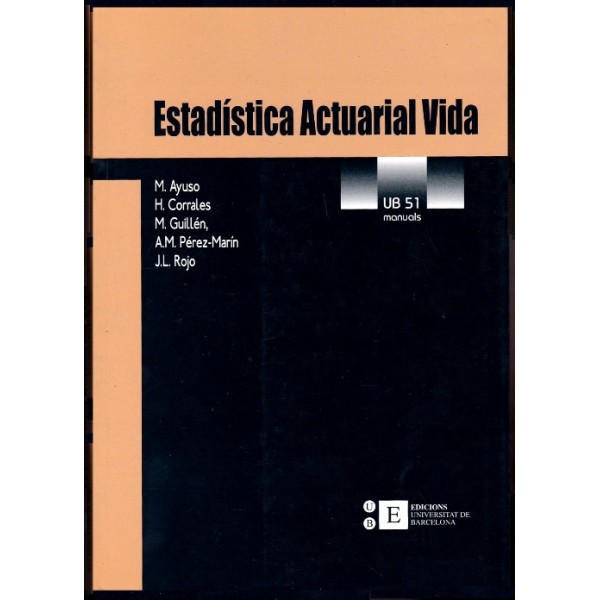Life tables - R programming
Mercedes Ayuso, Montserrat Guillén and Ana María Pérez-Marín
The complete practice guide can be found in:
- Ayuso, M., Corrales, H., Guillén, M., Pérez-Marín, A.M. and Rojo, J.L. (2007) Actuarial statistics for life insurance [Estadística actuarial vida], Publicacions i Edicions de la Universitat de Barcelona
DATA DESCRIPTION
| Name | Content description |
| H91_09_DEAD.csv |
Men death rates in Spain from 1991 to 2009. Source: INE. |
| H91_09_EXPO.csv |
Men exposure to risk in Spain from 1991 to 2009. Source: INE. |
| Mx1_x1SPAIN.txt |
Death rates in Spain since 1908 to 2006, from 0 years to +110. |
| Exposures_1x1SPAIN.txt |
Exposure to risk in Spain since 1908 to 2006, from 0 years to +110. |
ANALYSIS OF GROSS MORTALITY RATES AND BASIC LIFE TABLES
In this example we use data from the Human Mortality database and from the Spanish Statistics Institute (INE).
Namely, the script below shows how to read and plot gross death rates in a logarithmic scale and data on the exposure to the risk of mortality for Spain.We also plot the life expectancy at birth and from 65 years old for men and women. Additionally, we also plot death rates for male older than 65 and the life expectancy at different ages. Finally, we print a basic life tables for Spain.
- Script
DATA CLEANING OF GROSS MORTALITY RATES
We show different graphical methods to represent mortality rates as a function of age and calendar year.
In this way, mortality improvement over calendar time is shown by using different types of plots.Then, data cleaning of gross mortality rates is carried out by using alternative techniques (outlier imputations, smoothing techniques, linear extrapolation for advanced ages). More details can be found in Actuarial statistics for life insurance.
- Script
GRADUATION OF MORTALITY CURVES-STATIC
We show how to fit a Gompertz model to the mortality experience in one calendar year (static mortality curve):
\begin{equation} l_x = Kg^{C^{x}}, \,\,\,\,\,\,\,\,\,\,\,\, K > 0, \,\, 0 < g < 1, \,\, C>1. \\ lnl_x = lnK + C^{x}lng \,\,\,\,\,\,\,\,\,\,\,\,\,\,\,\,\,\,\,\,\,\,\,\,\,\,\,\,\,\,\,\,\,\,\,\,\,\,\,\,\,\,\,\,\,\,\,\,\,\,\, \end{equation} \begin{equation} q_x = 1-g^{C^{x}(C-1)} \,\,\,\,\,\,\,\,\,\,\,\,\,\,\,\,\,\,\,\,\,\,\,\,\,\,\,\,\,\,\,\,\,\,\,\,\,\,\,\,\,\,\,\,\,\,\,\,\,\,\,\,\,\,\,\,\,\,\,\,\,\,\,\,\,\,\,\\ ln(1-q_x) = C^x[(C-1)lng] \,\,\,\,\,\,\,\,\,\,\,\,\,\,\,\,\,\,\,\,\,\,\,\,\,\,\,\,\,\,\,\,\, \end{equation} \begin{equation} \mu_x = -lnglnCC^{x} \,\,\,\,\,\,\,\,\,\,\,\,\,\,\,\,\,\,\,\,\,\,\,\,\,\,\,\,\,\,\,\,\,\,\,\,\,\,\,\,\,\,\,\,\,\,\,\,\,\,\,\,\,\,\,\,\,\,\,\,\,\,\,\,\,\,\,\\ ln\mu_x = A + Bx \,\,\,\,\,\,\,\,\,\,\,\,\,\,\,\,\,\,\,\,\,\,\,\,\,\,\,\,\,\,\,\,\,\,\,\,\,\,\,\,\,\,\,\,\,\,\,\,\,\,\,\,\,\,\,\,\,\,\,\,\,\,\,\,\, \\ A = ln(-lnClng), B = lnC \,\,\,\,\,\,\,\,\,\,\,\,\,\,\,\,\,\,\,\,\,\,\,\,\,\,\,\,\,\,\,\,\, \end{equation}
where lx are the individuals alive at age x, qx is the death rate at age x and μx is the force of mortality at age x. K,g and C are parameters of the model.
- Script
ESTIMATION AND PREDICTION BY USING THE LEE-CARTER METHOD
In this example, we show how to estimate a Lee-Carter method, introduced by Lee and Carter (1992), to the mortality experience for spanish men older than 65 (time period 1975-2006). Additionally, the Lee-Carter prediction of the life expectancy is also carried out.
\begin{equation} ln\hat\mu_x(t) = ln\mu_x(t) + \epsilon_x(t), \,\,\,\,\,\,\,\,\,\,\,\,\,\,\,\,\,\,\,\,\,\,\,\,\,\,\,\,\,\,\,\,\,\,\,\, \\ \mu_x(t) = exp(\alpha_x + \beta_{x}k_{t}), \,\,\,\,\,\,\,\,\,\,\,\,\,\,\,\,\,\,\,\,\,\,\,\,\,\,\,\,\,\,\,\,\,\,\,\,\,\,\, \\ \epsilon_x(t) \sim \mathcal{N}(0,\sigma^2) \,\,\,\,\,\,\,\,\,\,\,\,\,\,\,\,\,\,\,\,\,\,\,\, \end{equation}- Script
ESTIMATION OF THE LTC MODEL EXTENSIONS AND MODEL SELECTION
We fit and compare three alternative models to mortality data for men, 1991-2009 (Spain). The three models are:
M1: Lee-CarterM5: CBD model
M7: Second generalization of the CBD model
- Script
REFERENCES
[1] Ayuso, M., Corrales, H., Guillen, M. et al. (2001) Estadística Actuarial Vida. Barcelona: Universitat de Barcelona.
[2] Brouhns, N. and Denuit, M. (2002) Risque de longévite et rentes viagères I. Evolution de la mortalité en Belgique de 1880 à nos jours. Belgian Actuarial Bulletin, Vol.2, No. 1, 26-48.
[3] Brouhns, N. and Denuit, M. (2002) Risque de longévite et rentes viagères II. Tables de mortalité prospectives pour la population belge. Belgian Actuarial Bulletin, Vol.2, No. 1, 49-63.
[4] Brouhns, N. and Denuit, M. (2002) Risque de longévite et rentes viagères III. Elaboration de tables de mortalité prospectives
pour la population assurée belge, et évaluation du coût de l'antisélection. Belgian Actuarial Bulletin, Vol.2, No. 1, 64-72.
[5] Cairns, A., Blake, D., Dowd, K. et al. (2009) A Quantitative Comparison of Stochastic Mortality Models Using Data from England & Wales and the United States. North American Actuarial Journal, Vol.13, No. 1, 1-35.
[6] Delwarde, A. and Denuit, M. (2003) Importance de la période d'observation et des âges considérés dans la projection de la mortalité selon la méthode de Lee-Carter. Belgian Actuarial Bulletin, Vol.3, No. 1, 1-21.
[7] Haberman, S. and Pitacco, E. (1999) Actuarial Models for Disability Insurance. United States: Cahpman & Hall/CRC.
[8] Knorr, F.E. (1984) Multidimensional Whittaker-Henderson graduation.Transactions of Society of Actuaries, Vol.36, 213-255.
[9] Lee, R. D. and Carter, L. (1992) Modeling and Forecasting the Time Series of U.S. Mortality. Journal of the American Statistical Association 87, 659-671.
[10] Pitacco, E., Denuit, M. et al. (2009) Modelling Longevity Dynamics for Pensions and Annuity Business. United States: Oxford University Press.
[11] Renshaw, A.E. and Haberman, S. (2003) On the forecasting of mortality reduction factors. Insurance: Mathematics and Economics, Vol.32, No. 3, 379-401.



